January 29,
2003
MOCNESS –
Multiple Opening and Closing Net and Environmental Sensing System
By Rachel McEvers, Project Oceanica
The MOCNESS will be one
of the main pieces of equipment used on this cruise. The MOCNESS samples
plankton, which are small organisms that are at the mercy of ocean currents.
During this cruise, the scientists are targeting ichthyoplankton (fish
larvae) and zooplankton (small animals such as crab larvae and copepods).
Phytoplankton (small single cell plants) will be sampled using a different
piece of equipment.
The MOCNESS has a series
of (below: MOCNESS net
mesh .5mm)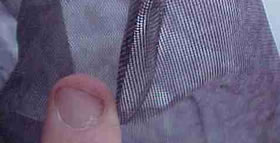 plankton nets, in this case nine, that are towed at different
depths. The mesh on the nets is half a millimeter (or 505 microns).
This size mesh is good for collecting ichthyoplankton. The scientists
have also added three zooplankton nets within three of the existing
ichthyoplankton nets. The mesh on the zooplankton nets is about 60/1000
of a millimeter (or 64 microns). If you’d like to have a MOCNESS
of your own, it costs about $50,000, nets included, so start saving
now!
plankton nets, in this case nine, that are towed at different
depths. The mesh on the nets is half a millimeter (or 505 microns).
This size mesh is good for collecting ichthyoplankton. The scientists
have also added three zooplankton nets within three of the existing
ichthyoplankton nets. The mesh on the zooplankton nets is about 60/1000
of a millimeter (or 64 microns). If you’d like to have a MOCNESS
of your own, it costs about $50,000, nets included, so start saving
now!
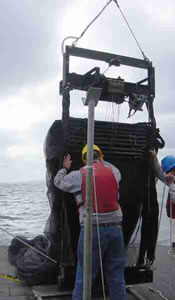 Here’s
how the MOCNESS works. The nets are gathered together and attached to
a frame. They each have a gate at their mouth, which allows the net
to open and close when appropriate. On the MOCNESS frame is a computer,
a battery, a motor and various other instruments that help the scientists
gather data and control the nets. The MOCNESS is connected to a computer
on the ship through a cable that also allows the ship to pull the MOCNESS.
The cable can withstand ~6000 pounds of pull, while still allowing the
MOCNESS and computer on the ship to talk to one another. A crane will
lift the MOCNESS with nets still gathered together and lower it into
the water. Here’s
how the MOCNESS works. The nets are gathered together and attached to
a frame. They each have a gate at their mouth, which allows the net
to open and close when appropriate. On the MOCNESS frame is a computer,
a battery, a motor and various other instruments that help the scientists
gather data and control the nets. The MOCNESS is connected to a computer
on the ship through a cable that also allows the ship to pull the MOCNESS.
The cable can withstand ~6000 pounds of pull, while still allowing the
MOCNESS and computer on the ship to talk to one another. A crane will
lift the MOCNESS with nets still gathered together and lower it into
the water.
( at left: the MOCNESS frame)
A winch will then let out the cable and the MOCNESS will sink to a certain
depth. The scientists will close the first net and open the second net
by sending a message from the computer on the ship, through the cable,
to the MOCNESS computer. The MOCNESS will also send information through
the cable to shipboard computer allowing the scientists to “see”
the angle of the net, the volume of water flow filtered by the net,
the water temperature, the water salinity and many other variables.
This information is sent every 2 seconds from the MOCNESS to the shipboard
computer. When that net has been towed for 5 minutes, the scientists
will send another message to the MOCNESS to close the second net and
open the third net. Each successive net is a little less deep than those
before it, so that the scientists will get samples from different depths
in the water column. On this cruise, samples will be taken at nine specific
depths from 200 meters deep to the surface.
The messy part comes when
the nets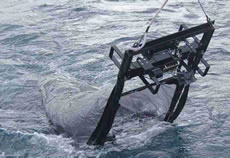 are brought to the surface. Normally there is a plastic “cup”
or “codend” at the bottom of the plankton net, but if the
temperature is too low, these plastic cups can get brittle and break.
Therefore, the scientists during this cruise will just tie the ends
of the nets tightly and wash the samples from the net with a hose. The
samples will be preserved and taken back to (at
left: the MOCNESS at the surface) the lab at the end of the cruise
for sorting and identification. It takes scientists several hours to
sort and identify the plankton in one sample. 48 samples will be collected
per day for the next 2 weeks!!
are brought to the surface. Normally there is a plastic “cup”
or “codend” at the bottom of the plankton net, but if the
temperature is too low, these plastic cups can get brittle and break.
Therefore, the scientists during this cruise will just tie the ends
of the nets tightly and wash the samples from the net with a hose. The
samples will be preserved and taken back to (at
left: the MOCNESS at the surface) the lab at the end of the cruise
for sorting and identification. It takes scientists several hours to
sort and identify the plankton in one sample. 48 samples will be collected
per day for the next 2 weeks!!
Career of the day
Rachel McEvers, Program Manager for Project Oceanica
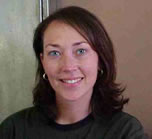 Rachel’s
organization, Project Oceanica is located on the campus of the College
of Charleston in Charleston, SC. Oceanica is funded by NOAA’s
National Ocean Service. She has a Bachelor’s degree in both Public
Relations and Marine Biology. Rachel decided she wanted to be a marine
scientist when she was very young. She was always fascinated by TV shows
and books that anything to do with ocean creatures. Rachel’s
organization, Project Oceanica is located on the campus of the College
of Charleston in Charleston, SC. Oceanica is funded by NOAA’s
National Ocean Service. She has a Bachelor’s degree in both Public
Relations and Marine Biology. Rachel decided she wanted to be a marine
scientist when she was very young. She was always fascinated by TV shows
and books that anything to do with ocean creatures.
Rachel participates on research cruises throughout
the southeast and helps create educational and outreach products from
the science operations conducted on the cruises. She also helps instruct
high school students on one-day research cruises and helps run the administrative
aspect of Project Oceanica.
The thing she likes best about her job is being
outdoors and near the ocean. The thing she likes least is being cooped
up in her office when she’s not outside! If she could be any sea
creature she would be a gulper eel. Why? Because “they’re
so strange looking and live in such an alien environment. They’re
just bizarre.”
|

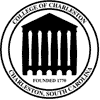

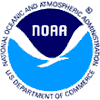
 plankton nets, in this case nine, that are towed at different
depths. The mesh on the nets is half a millimeter (or 505 microns).
This size mesh is good for collecting ichthyoplankton. The scientists
have also added three zooplankton nets within three of the existing
ichthyoplankton nets. The mesh on the zooplankton nets is about 60/1000
of a millimeter (or 64 microns). If you’d like to have a MOCNESS
of your own, it costs about $50,000, nets included, so start saving
now!
plankton nets, in this case nine, that are towed at different
depths. The mesh on the nets is half a millimeter (or 505 microns).
This size mesh is good for collecting ichthyoplankton. The scientists
have also added three zooplankton nets within three of the existing
ichthyoplankton nets. The mesh on the zooplankton nets is about 60/1000
of a millimeter (or 64 microns). If you’d like to have a MOCNESS
of your own, it costs about $50,000, nets included, so start saving
now!  Here’s
how the MOCNESS works. The nets are gathered together and attached to
a frame. They each have a gate at their mouth, which allows the net
to open and close when appropriate. On the MOCNESS frame is a computer,
a battery, a motor and various other instruments that help the scientists
gather data and control the nets. The MOCNESS is connected to a computer
on the ship through a cable that also allows the ship to pull the MOCNESS.
The cable can withstand ~6000 pounds of pull, while still allowing the
MOCNESS and computer on the ship to talk to one another. A crane will
lift the MOCNESS with nets still gathered together and lower it into
the water.
Here’s
how the MOCNESS works. The nets are gathered together and attached to
a frame. They each have a gate at their mouth, which allows the net
to open and close when appropriate. On the MOCNESS frame is a computer,
a battery, a motor and various other instruments that help the scientists
gather data and control the nets. The MOCNESS is connected to a computer
on the ship through a cable that also allows the ship to pull the MOCNESS.
The cable can withstand ~6000 pounds of pull, while still allowing the
MOCNESS and computer on the ship to talk to one another. A crane will
lift the MOCNESS with nets still gathered together and lower it into
the water. are brought to the surface. Normally there is a plastic “cup”
or “codend” at the bottom of the plankton net, but if the
temperature is too low, these plastic cups can get brittle and break.
Therefore, the scientists during this cruise will just tie the ends
of the nets tightly and wash the samples from the net with a hose. The
samples will be preserved and taken back to (at
left: the MOCNESS at the surface) the lab at the end of the cruise
for sorting and identification. It takes scientists several hours to
sort and identify the plankton in one sample. 48 samples will be collected
per day for the next 2 weeks!!
are brought to the surface. Normally there is a plastic “cup”
or “codend” at the bottom of the plankton net, but if the
temperature is too low, these plastic cups can get brittle and break.
Therefore, the scientists during this cruise will just tie the ends
of the nets tightly and wash the samples from the net with a hose. The
samples will be preserved and taken back to (at
left: the MOCNESS at the surface) the lab at the end of the cruise
for sorting and identification. It takes scientists several hours to
sort and identify the plankton in one sample. 48 samples will be collected
per day for the next 2 weeks!!  Rachel’s
organization, Project Oceanica is located on the campus of the College
of Charleston in Charleston, SC. Oceanica is funded by NOAA’s
National Ocean Service. She has a Bachelor’s degree in both Public
Relations and Marine Biology. Rachel decided she wanted to be a marine
scientist when she was very young. She was always fascinated by TV shows
and books that anything to do with ocean creatures.
Rachel’s
organization, Project Oceanica is located on the campus of the College
of Charleston in Charleston, SC. Oceanica is funded by NOAA’s
National Ocean Service. She has a Bachelor’s degree in both Public
Relations and Marine Biology. Rachel decided she wanted to be a marine
scientist when she was very young. She was always fascinated by TV shows
and books that anything to do with ocean creatures.